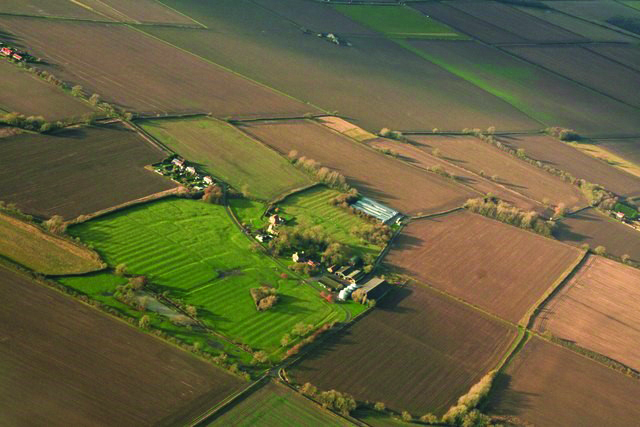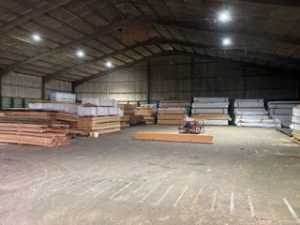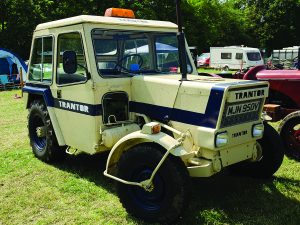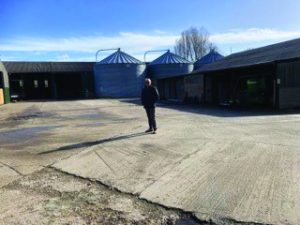Manor Farm Interview: Reflections of a Lincolnshire Family Farm

Manor Farm is in Buslingthorpe – a small hamlet, approximately 3 square miles in area, and comprises a moat, 1 farm, St Michael’s Church (now disused) and approximately 20 houses. The name Buslingthorpe is unique in that it has half the letters of the alphabet with none repeated! In this aerial photograph, the ridge and furrow fields seen around the farm are an English Heritage site of a medieval village. Here local farmer, Charles Wheeldon kindly gives us a fascinating history…
My Grandfather, Fred Strawson, born in 1888, was set up by his father at the age of 21 on a tenanted farm at Grainthorpe, in the Lincolnshire marshes. In those days unploughable, the land was down to grass, and Fred bred Lincolnshire Longwool sheep and Aberdeen Angus cattle, which he continued to do until the day he died in his yard at Thoresway at the age of 95 in 1985.
In 1912 Fred took the tenancy of Manor Farm, Buslingthorpe, 725 acres on the opposite side of the Wolds, near Market Rasen, on the Sutton’s Hospital in Charterhouse Estate, purchasing the larger part of it five years later. He bought several farms over the years, but this was the first and most expensive, at £20/ac. Between the wars he bought a farm at West Rasen for £4/10s/ac.
Fifty years to the day, his grandsons Tony and Charles Wheeldon took the farm on in 1967, under the trading name of Wheeldon and Sons, purchasing the remainder of the tenanted land some ten years later. This was at a time, in agricultural terms, when farming was just beginning to move on from the restrictions of the war, with huge strides being made in science and technology.
For two young farmers fed up with chasing stock at nights and weekends, the chance to plough land that had benefited from centuries of grass and livestock to grow arable crops was enthusiastically grasped. Intensive livestock production of pigs, and particularly chicken, which had long been a luxury, saw a huge demand for wheat and barley which the steady increase in crop yields and area sown helped to satisfy.
In those days, 60 horse power was common for the average tractor, pulling two furrows on the heavy loamy clay soil at Buslingthorpe. Several cultivations with a range of discs, harrows and spring tines would hopefully produce a seedbed where twenty acres drilling would be a good day’s work. A 10ft combine bed was as big as the men bagging off could handle. The first sprayer on the farm, all of 15ft width, was being used in the mid ‘60s.
Rather surprisingly, to us at least, grandfather had erected one of the first A-framed 60×90 800t on-floor grain stores in Lincolnshire in 1965; in retrospect, it was probably his way of giving a leg-up to the future incumbents of the farm.
It was an exciting time for young farmers who were not under the constraint of the traditions of the previous generations. All aspects of arable farming were improving; machinery, cultivating diseases. There were downsides, as when the first black grass appeared on the farm – we had no idea what it was!
Agriculture was still being supported by government, and there were grants for many improvements, including drainage, hedge removal and buildings. There was even a grant for fertiliser. In our first year we bought 0-20-20 fertiliser at the Lincolnshire Show for £15/t. However, the oats that year which yielded 30cwt/ac were sold for £17/t!
Farmers were enthusiastic at the UK’s entry into the Common Market (little realising it was the back door to an EU) for the continued support it was giving to food production. Prices and margins were gradually increasing, but it wasn’t until the oil crisis in 1972 that a step change took place. Trading at about £30/t, the price of wheat jumped overnight by £5, which many thought was too good to be true, and took advantage of. Without the upto-the-minute market information available today, many didn’t realise what was happening, and were dismayed to see the price rise to over £40/t soon after, feeling that they had been misled by the trade.
The heatwave of 1976 saw high prices for grain, if you had any, and 1984, with the introduction of Huntsman feed wheat, which increased yields by 25%, was memorable for the bumper harvest and high prices which caused much grief when the higher rate of tax was still 60% and took us many years to pay off.
The erection of the grain store in 1965 entailed 18th century buildings and open yards, and over the following the demolition of years all the traditional buildings were replaced with modern yards and stores. Keen to do away with the old, unfortunately no photos were kept of the old buildings, crews and stackyards.
The yard was concreted, and a 100×120 cattle yard built in 1972. The cattle were short-lived, and the building converted to grain and general storage. A 500t Condor 10 bin store with cleaning and weighing facilities was built in 1979 to accommodate the seed crops that were being grown on the farm at the time.

The oilseed rape store now rented by a timber importer.
The glut of grain that was being produced by the early ‘80s saw the introduction of intervention storage, and the higher standards of moisture and admixture required. The cleaning facility on the farm was being utilised by local farmers, and it became apparent that the on-floor drying facilities that were adequate for drying grain to the traditional 16% for trading could not meet the new level of 14.5%. Charles decided to set up a new mobile contract drying business, wittily named “Home and Dry”, to hire out mobile driers for farmers to dry their own corn on farm before delivery, to avoid high merchants charges. Two 20t mobile driers and a Trantor were purchased, and were kept busy around Lincolnshire, with excursions into Nottinghamshire and Yorkshire, for the next ten or a dozen years. Demand dropped as farmers improved their storage systems, and central stores took all the hassle away for those wanting to move grain off the farm at harvest.

Trantor Tractor Series 1 (1980)
In 1984 the expanding area of oilseed rape being grown by farmers unable to dry and store it opened the opportunity to erect a shed where 3,500t of seed, dried if necessary through the mobile driers, could be stored for local merchants. A further 2000t of storage in 4x500t silos followed over the years, and apart from some harvest help, Charles ran the store single-handed for over 30 years.
Having farmed in partnership for 30 years, the brothers realised that for succession reasons, the farm would need to be split, and they went their different ways. After a proposal to Charles from Steve Turley that joining forces would benefit both farms, a joint venture business was set up in the mid ‘90s. Unlike a contracting or machinery sharing agreement between farmers, this arrangement was unique at the time in that everything was thrown into the pot and the outcome shared pro rata. This made it easier for the manager, who didn’t have worry about prioritising one or other farm.
Over the years three more local farmers joined what then became Flagleaf Farming, which, with some contract farms, grew to manage over 8,000ac.

Charles in the yard today.
By 2021, after Brexit, and the introduction of the new ELMS agricultural support scheme, the model of Flagleaf Farming, set up as a mainly combine cropping operation, was becoming outdated. With the next generation beginning to get involved in the individual businesses with new ideas, it was agreed that Flagleaf should be wound up, and farms taken back in hand. One of the options of ELMS was a retirement package, and having no one following on, Charles opted to take this. Selling some of his land to brother Tony, and letting the rest, the business of Wheeldon and Sons, established in April 1967, ceased trading in February 2023.
Woldmarsh Producers was founded by 12 like-minded farmers as a buying group in 1961, and if Grandfather Fred Strawson was not one of those 12, he joined very soon after.
Wheeldon and Sons joined the group in 1968, and purchased oil, grease and paint from the then Witham Oil Company from the outset. This connection was maintained with the move to Flagleaf Farming where the vast machinery of today would consume quantities unimaginable 55 years ago.
There was one oil that Witham was not able to provide, though, which was that for the aircraft that Charles flew Witham MD Nigel Bottom to Le Mans for the Classic a few years ago!
Witham has supplied many Lincolnshire farms, whether through Woldmarsh or directly, throughout the years, and will continue to do so through the changes in the years to come.

Charles now enjoys using his private pilot’s licence but sadly Witham does not supply aviation lubes!



Leave a Reply